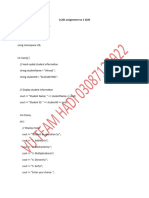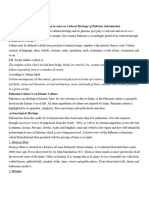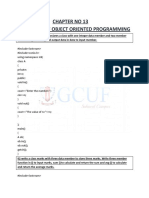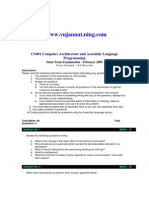0 ratings0% found this document useful (0 votes)
2K views4-Const Vs Non-Const Functions Amd Static Data Members Functions
The document discusses constant and non-constant member functions and static data members in C++, explaining that constant member functions cannot modify the object and can be called by constant objects, while non-constant functions can only be called by non-constant objects; it also explains that static data members and static member functions exist as single copies shared across all objects rather than being created for each object.
Uploaded by
Ahmed Shajee Asim KhanCopyright
© © All Rights Reserved
We take content rights seriously. If you suspect this is your content, claim it here.
Available Formats
Download as PPTX, PDF, TXT or read online on Scribd
0 ratings0% found this document useful (0 votes)
2K views4-Const Vs Non-Const Functions Amd Static Data Members Functions
The document discusses constant and non-constant member functions and static data members in C++, explaining that constant member functions cannot modify the object and can be called by constant objects, while non-constant functions can only be called by non-constant objects; it also explains that static data members and static member functions exist as single copies shared across all objects rather than being created for each object.
Uploaded by
Ahmed Shajee Asim KhanCopyright
© © All Rights Reserved
We take content rights seriously. If you suspect this is your content, claim it here.
Available Formats
Download as PPTX, PDF, TXT or read online on Scribd
You are on page 1/ 11
Constant vs Non
Constant Functions and
Static Data Members &
Functions
Overvie
w
• Constant Member Function
• Non Constant Function
• Data members and Member Functions Memory Representation
• Static Data Member
• Static Member Functions
Constant Member
Function
• The const member functions are the functions which are declared as
constant in the program.
• The object called by these functions cannot be modified.
• It is recommended to use const keyword so that accidental changes to
object are avoided.
• A const member function can be called by any type of object.
• Non-const functions can be called by non-const objects only.
• The syntax of const member function in C++ language,
• Return Type function_name() const { function body}
Exampl
e
• By Compiling this code which Error You had Seen??
Non Constant
Function
• A const member function can be called by any type of object.
• Non-const functions can be called by non-const objects only.
• In this example the non constant function
• Can not be accessed by constant object
• It will show error
• passing 'const Test' as 'this' argument of 'int
• Test::getValue()' discards qualifiers
Data members and Member
Functions Memory Representation
• Each newly created object have copies of that class’s data and
member functions.
• The member functions are created and placed in memory only once when
they are defined in the class definition.
• This makes sense; there’s really no point in duplicating all the
member functions in a class every time you create another object of that
class,
• since the functions for each object are identical.
• The data items, however,
• will hold different values, so there must be a separate instance of each data
item for each object.
• Data is therefore placed in memory when each object is defined, so there is
a separate set of data for each object.
Exampl
e
Static Data
Member
• We can define class members static using static keyword.
• When we declare a member of a class as static it means no matter how
many objects of the class are created, there is only one copy of the static
member.
• A static member is shared by all objects of the class.
• All static data is initialized to zero when the first object is created, if no
other initialization is present.
• We can't put it in the class definition but it can be initialized outside the
class as done in the following example by redeclaring the static variable,
using the scope resolution operator :: to identify which class it belongs to.
Output
Representation of objects in Memory
Static Member
Functions
• By declaring a function member as static, you make it independent of any
particular object of the class.
• A static member function can be called even if no objects of the class exist
and the static functions are accessed using only the class name and the
scope resolution operator ::.
• A static member function can only access static data member, other static
member functions and any other functions from outside the class.
• Static member functions have a class scope
• You could use a static member function to determine whether some
objects of the class have been created or not.
Output
You might also like
- 12th Computer Science Guess Papers +subjective + MCQs by Urdu BooksNo ratings yet12th Computer Science Guess Papers +subjective + MCQs by Urdu Books28 pages
- Assignment Sample of GC University Faisalabad100% (1)Assignment Sample of GC University Faisalabad25 pages
- Objectives and Perspective of Assembly Language100% (1)Objectives and Perspective of Assembly Language20 pages
- Lab # 4 Objective Theory: To Understand Branching and Simulate VVM Programs Using"brp", "BRZ" & "BR" InstructionsNo ratings yetLab # 4 Objective Theory: To Understand Branching and Simulate VVM Programs Using"brp", "BRZ" & "BR" Instructions13 pages
- Reasons For Delay in The Constitution Making of PakistanNo ratings yetReasons For Delay in The Constitution Making of Pakistan3 pages
- William Stallings Computer Organization and Architecture 6th Edition Cache MemoryNo ratings yetWilliam Stallings Computer Organization and Architecture 6th Edition Cache Memory54 pages
- Sample Question Paper - Object Oriented Programming-1206350% (2)Sample Question Paper - Object Oriented Programming-120634 pages
- Object Oriental Programming First Three Chapter ProgramNo ratings yetObject Oriental Programming First Three Chapter Program56 pages
- University Course Details Management System in C++60% (5)University Course Details Management System in C++20 pages
- Association - Aggregation and Composition OOPsNo ratings yetAssociation - Aggregation and Composition OOPs8 pages
- Programming Using C++: Muhammad Saleem RazaNo ratings yetProgramming Using C++: Muhammad Saleem Raza32 pages
- Bahria University (Karachi Campus) : Midterm Examination - Spring Semester - 2020 (Computer Programming CSC-113)No ratings yetBahria University (Karachi Campus) : Midterm Examination - Spring Semester - 2020 (Computer Programming CSC-113)4 pages
- Imagine A Publishing Company That Markets Both Books and Audio100% (1)Imagine A Publishing Company That Markets Both Books and Audio4 pages
- 1st Year Computer Science MCQs Solved Zahid NotesNo ratings yet1st Year Computer Science MCQs Solved Zahid Notes15 pages
- Principles of Money & Banking: By. Prof Riaz Ahmed MianNo ratings yetPrinciples of Money & Banking: By. Prof Riaz Ahmed Mian32 pages
- Arrays With in A Class: Const Int Size 10 Class Array (Int A (Size) Public: Void Setval (Void) Void Display (Void) )No ratings yetArrays With in A Class: Const Int Size 10 Class Array (Int A (Size) Public: Void Setval (Void) Void Display (Void) )19 pages
- Testing and Commissioning Progress Chart For Low Voltage Cubicle Switchboard Installation (Rev.)No ratings yetTesting and Commissioning Progress Chart For Low Voltage Cubicle Switchboard Installation (Rev.)1 page
- Data Center Project Management - DP Air CorpNo ratings yetData Center Project Management - DP Air Corp10 pages
- Fondeadora, The Digital Solution To The Old Banks: We Are Mexico's Fastest-Growing Challenger BankNo ratings yetFondeadora, The Digital Solution To The Old Banks: We Are Mexico's Fastest-Growing Challenger Bank2 pages
- The Internet Is For Porn Measurement and Analysis of Online Adult TrafficNo ratings yetThe Internet Is For Porn Measurement and Analysis of Online Adult Traffic10 pages
- Chapter 4: Product and Service Design: Goods and Services It Offers Capability of An Organization ToNo ratings yetChapter 4: Product and Service Design: Goods and Services It Offers Capability of An Organization To12 pages
- Corelink Mmu600 System Memory Management Unit Technical Reference Manual 100310 0202 00 enNo ratings yetCorelink Mmu600 System Memory Management Unit Technical Reference Manual 100310 0202 00 en144 pages

























































































